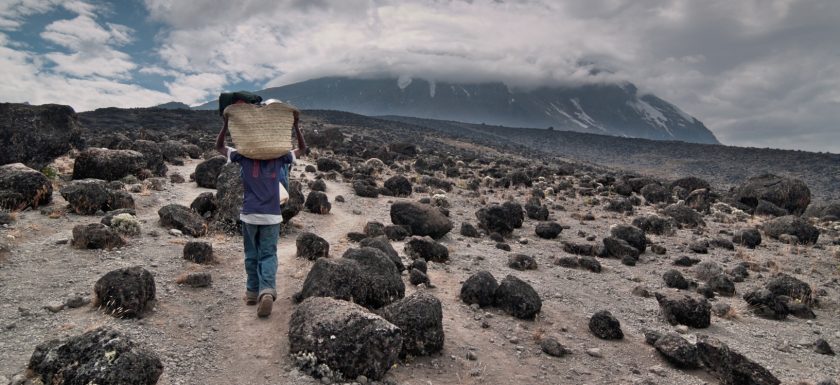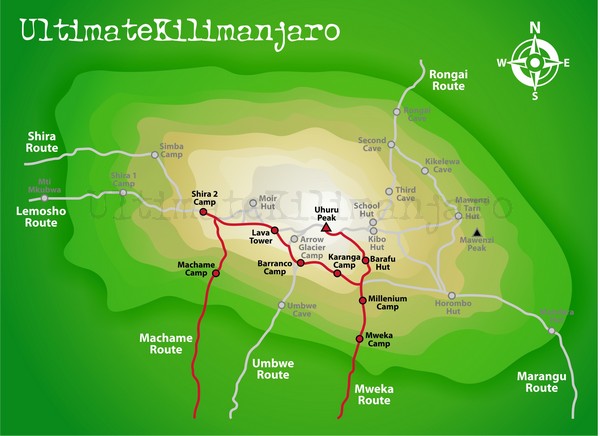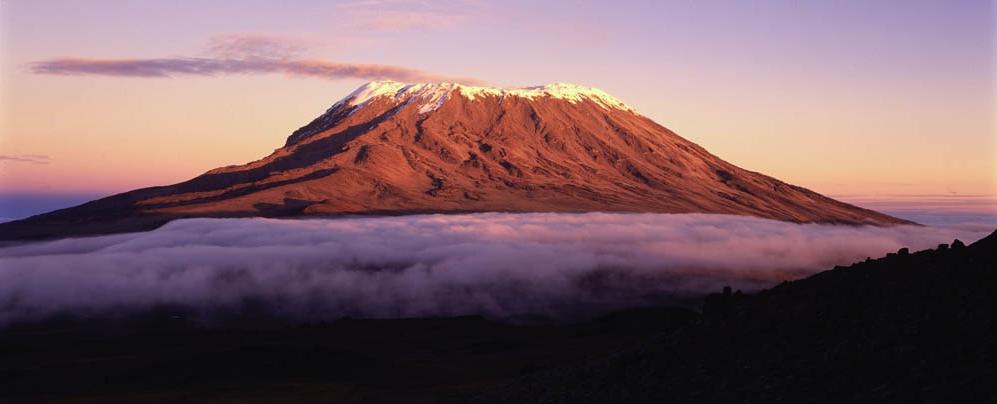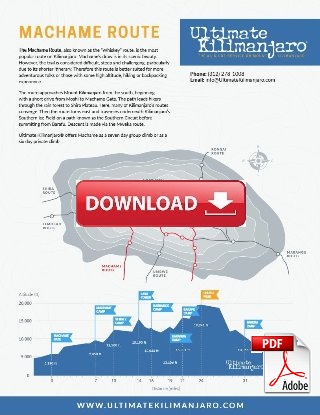
MACHAME – THE MOST POPULAR ROUTE ON KILIMANJARO
Welcome to Machame.com
If you’re reading this, you’re probably interested in climbing Kilimanjaro on the Machame Route. You’re in good company. The Machame route is the most popular route on Mount Kilimanjaro. It is the route of choice for many people because it provides impressive views and a variety of habitats. About 50% of all climbers, and most seasoned climbers, choose the Machame route for their trip. It is also one of the cheaper routes due to its easy access and shorter itinerary.
The Machame route is also known as the Whiskey route, given its reputation for being a tough climb, in contrast to the easier Marangu route, which is known as the Coca Cola route. Unlike the gradual incline and hut accommodations found on the Marangu Route, the climbers on Machame hike steeper trails, for longer distances, while sleeping in tents.
The Machame route on Kilimanjaro is a moderately difficult trail, but very doable even for first time backpackers with little to no altitude experience. This route is recommended for those who want a shorter route due to its good acclimatization profile.

About the Machame Route
The trek begins at Machame Gate, located in the southern base of mountain, which is just a short drive from Moshi or Arusha.
The hike starts within Kilimanjaro’s lush, fertile, montane rainforest. As you might expect, the lower slopes receive a quite a bit of precipitation. The trail may be steep and slippery, so trekking poles are advised. As the route heads toward the Shira Plateau, the trees disappear and are replaced by low brush in the heather zone.
Then, the route climbs high to the volcanic plug, Lava Tower, before dropping and circling below the South Icefield. This circular pathway from Barranco to Karanga to Barafu is known as the southern circuit. As it traverses halfway around the mountain, climber’s are exposed to great vistas.
The long, strenuous approach to the summit is made from the east through endless switchbacks up increasingly loose gravel until we reach the crater rim at a mark known as Stella Point. Then the route is relatively flat for another hour to Uhuru Peak – the top of Mount Kilimanjaro. The quick descent follows the Mweka trail.
How Long Does it Take to Climb Kilimanjaro Using the Machame Route?
The Machame Route climb can be done in a minimum of six days (five nights) on the mountain. However, it is most often tackled over seven days (six nights), for a better altitude acclimatization schedule. The success rate is significantly higher when using the seven day route.
The Machame Route is approximately 62 km/ 37 miles from gate to gate, with an elevation gain of about 16,000 to 17,000 feet.
Machame is designed for those with above average fitness and some hiking experience. But, plenty of first time trekkers use the route as well and do just fine. It is rated as one of Kilimanjaro’s better routes and thus is recommended. It is certainly a better choice than the typical tourtist’s route – Marangu.
The table below depicts a variation of the 7 day Machame climb with starting and finishing points, altitude, distance and hiking time. This is considered to be the ideal Machame route variation.

How Much Does it Cost to Climb Kilimanjaro Using the Machame Route?
The cost of climbing Kilimanjaro on the Machame route ranges from $2,000 to $6,000 depending on which operator you choose, the duration of the trip, and the number of clients in your party.
The Machame route can be climbed in 6 or 7 days. Because of the increase in park permits, crew wages, and food costs, the price of the 7 day Machame route is higher than the 6 day variation.
Our current pricing for a party of 4 for Machame route tours are shown below.
Machame Route Cost:
- Machame 6 Day Itinerary (ok) – $2,599 per person, private climb
- Machame 7 Day Itinerary (preferred) $2,799 per person, private climb or $2,699 per person, group climb
How Hard is it to Climb Kilimanjaro Using the Machame Route?
The Machame route is considered a difficult route. The reason being that it is a steep trail and has more elevation gain than other routes.
A route profile, sometimes called an elevation profile, is a side view of geographical data which focuses on elevation. The Machame route gains and loses altitude throughout the trip, which requires more fitness to hike compared to other routes that are more of a gradual ascent.

However, this up and down movement is actually very beneficial for acclimatization because it follows the “climb high, sleep low” principle. Climb high, sleep low is a strategy by which you sleep at a lower elevation to which you have ascended during the day. This is known to stimulate the body to produce more red blood cells which carry oxygen.
So even though the route profile is considered difficult, Machame’s summit success rate is decent, around 70%-80% when done over 7 days.
How Many Kilimanjaro Routes are There?
There are seven major routes on Mount Kilimanjaro. Each is well maintained, and each route has different pros and cons.
The seven routes on Mount Kilimanjaro are:
- Machame Route
- Lemosho Route
- Marangu Route
- Rongai Route
- Shira Route
- Northern Circuit Route
- Umbwe Route
Foot traffic on the routes is regulated by the Kilimanjaro National Park Authority. It is required to have a guide for tours on Kilimanjaro.
How Hard is it to Climb Kilimanjaro?
Mount Kilimanjaro is a challenging peak to climb. Many people tackle the mountain every year, and not just hard core backpackers and experienced mountaineers. It is suitable for beginners or novices as well.
Everyday people, including accountants, engineers, food servers and teachers, successfully reach the top. Children as young as 6 years old and seniors as old as 89 years old have done it. Experts agree that anyone who is in average physical shape can climb Kilimanjaro, which is why the mountain is so popular amongst the general adventure seeking population. No technical mountaineering ability is required.
We guide over 1,000 clients to the summit of Kilimanjaro annually. Many of our participants have never been on such a tall mountain and have limited hiking experience. It shows us that you don’t have to be super fit or even a particularly strong hiker.
As long as you are in decent shape, you have a good chance of reaching the top.
The key to climbing Kilimanjaro is ascending slowly. By gradually increasing the elevation, the body has sufficient time to adapt to the low oxygen environment. Trip length is the most important factor when it comes to successfully climbing Kilimanjaro as the primary reason people fail is due to altitude sickness, not physical exhaustion. In other words, those who acclimatize well will most likely make it to the top. Those who don’t will not.
About Kilimanjaro
Mount Kilimanjaro is the tallest mountain in Africa. It stands an impressive 19,341 feet tall over the Tanzanian plains. Mount Kilimanjaro is also the tallest free standing mountain in the world, meaning it is not part of a mountain range (such as Mount Everest and the Himalayans).

The weather on the mountain varies widely depending on the elevation and season. It can be extremely cold near the summit, so warm, windbreaking clothing is a necessity. Heavy rain is also possible at any time, so quality waterproof gear is mandatory. All climbers should be well equipped.
The best time to climb Kilimanjaro is during the dry season. January, February, July, August, September, October are the best months to go. The rainy season occurs during the months of March, April, May, June, November and December. Kilimanjaro can be climbed year round.
